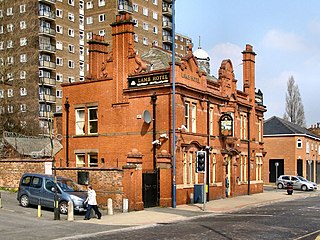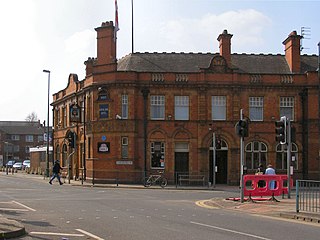
Salford is a city in Greater Manchester, England, situated on the western bank of the River Irwell which forms its boundary with Manchester city centre. Landmarks in the city include the former town hall, Salford Cathedral, Salford Lads' Club and St Philip's Church. In 2021 it had a population of 129,794. The demonym for people from Salford is Salfordian.

Mossley (/ˈmɒzli/) is a town and civil parish in Tameside, Greater Manchester, England. It is located in the upper Tame Valley and the foothills of the Pennines, 3 miles (4.8 km) south-east of Oldham and 9 miles (14.5 km) east of Manchester. In 2011 it had a population of 10,921.

Salford, also known as the City of Salford, is a metropolitan borough with city status in Greater Manchester, England. The borough is named after its main settlement, Salford, but covers a larger area which includes the towns of Eccles, Swinton, Walkden and Pendlebury. The borough had a population of 278,064 in 2022, and is administered from the Salford Civic Centre in Swinton.

Eccles is a market town in the City of Salford in Greater Manchester, England, 3 miles (4.8 km) west of Salford and 4 miles (6.4 km) west of Manchester, split by the M602 motorway and bordered by the Manchester Ship Canal to the south. The town is famous for the Eccles cake.

The Portico Library, The Portico or Portico Library and Gallery on Mosley Street in Manchester, England, is an independent subscription library designed in the Greek Revival style by Thomas Harrison of Chester and built between 1802 and 1806. It is recorded in the National Heritage List for England as a Grade II* listed building, having been designated on 25 February 1952, and has been described as "the most refined little building in Manchester".

Piccadilly Gardens is a green space in Manchester city centre, England, on the edge of the Northern Quarter.

St. Augustine's Church is an active Anglican church in Pendlebury, Greater Manchester, England. Dedicated to St Augustine, it is part of the benefice of Swinton and Pendlebury along with St Peter's Church in Swinton and All Saints' Church in Wardley. The church is in the Eccles deanery, the archdeaconry of Salford and the diocese of Manchester. The church was granted Grade II* listed status in 1966 but has since been upgraded to Grade I.
Irlams o' th' Height is a suburb of Salford, Greater Manchester, England, on top of the Irwell Valley, on higher ground than Pendleton, hence the name. The first part of the name derives from the Irlam family that ran the Pack Horse Inn in the 17th and 18th centuries.

St Mary the Virgin's Church is an active Anglican parish church in Eccles, Greater Manchester, England. The church is in the Eccles deanery, the archdeaconry of Salford and the diocese of Manchester. Together with St Andrew's Eccles, St Paul's, Monton, Christ Church, Patricroft and St James', Hope the church is part of the team benefice of Eccles. The church was granted Grade I Listed status in 1964.

The Church of St Mary the Virgin, Deane, is an Anglican parish church in Deane, Bolton, Greater Manchester, England. It is a member of Deane deanery in the archdeaconry of Bolton, diocese of Manchester. It is a Grade II* listed building.

There are 48 Grade I listed buildings in Greater Manchester, England. In the United Kingdom, the term listed building refers to a building or other structure officially designated as being of special architectural, historical or cultural significance; Grade I structures are those considered to be "buildings of exceptional interest". In England, the authority for listing under the Planning Act 1990 rests with Historic England, a non-departmental public body sponsored by the Department for Culture, Media and Sport.

Weaste Cemetery, previously known as Salford Borough Cemetery, is a public Grade II listed Victorian cemetery in Weaste, Salford. Opened in 1857, it is the oldest of Salford's four cemeteries, covering 39 acres (16 ha) and containing over 332,000 graves. It was established due to the overcrowding of churchyards, officially opening on 1 September 1857, with its first interment being Joseph Brotherton on 14 January 1857. The cemetery, which was bombed during the 1940 Manchester Blitz, now features a heritage trail and guided tours, with several Grade II listed monuments. It also holds graves of 373 Commonwealth service personnel from both World Wars, with special memorials and listings for those buried abroad and in unmarked graves.
The Railway is a Grade II listed pub in Altrincham, Greater Manchester, England.

The Old White Lion is a Grade II listed pub in Bury, Greater Manchester, England.
The Grapes is a Grade II listed pub in Eccles, Salford, England.

The Lamb Hotel is a Grade II listed pub in Eccles, Salford, England.

The Royal Oak is a Grade II listed former pub in Eccles, Salford, England.

The Shakespeare is a Grade II listed pub in Farnworth, Greater Manchester, England.

The Briton's Protection is a historic, Grade II listed public house in Manchester, England. Various dates are given for its establishment; the pub's own website says 1806, although its bicentenary was not celebrated until 2011. It was listed in Pigot and Dean's New Directory of Manchester & Salford for 1821 and 1822.
Eccles is a town in the City of Salford Metropolitan Borough, Greater Manchester, England. The town, which includes the area of Patricroft, contains 25 listed buildings that are recorded in the National Heritage List for England. Of these, one is listed at Grade I, the highest of the three grades, three are at Grade II*, the middle grade, and the others are at Grade II, the lowest grade.

















